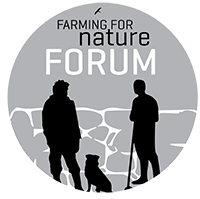Watercourses & Ponds
Ponds
‘Why should every farmer build a pond!’
by Tommy Earley
About Tommy Earley
More information and a short film on Tommy’s farm here. Ambassador since 2019
‘Why build a pond on your farm?’
by Clive Bright
Gabe Brown says water is life and that he wants to keep every drop of rain that falls on his farm. In Ireland, water and rain are often maligned. With the average rainfall increasing every decade, it creates ground conditions that are difficult to manage. Thousands of euro and many hours are spent on draining water off the land; the notion of holding it on the farm may sound crazy.
The truth is, in many cases, the need to drain water off the land is a symptom of an ineffective water-cycle. Soil is too compacted to allow water to infiltrate. Therefore it runs-off, taking soil particles with it, or it pools in flashes on the surface. When the soil is well structured, the infiltrating water recharges aquafers and passively makes its way to stream rivers and the sea. Such soil can hold thousands of litres in its depths, and feed plants though drought and prevent flash flooding in wet weather. The reality is, especially in heavy soil areas, it is quite difficult to achieve this level of soil function without very considered management. It is an interesting exercise to investigate in a field higher than the water table prone to flash flooding – when there is surface water, dig a square hole a spades width, and you will almost certainly find that the soil a few inches down from the saturated surface is bone dry.
There is a plus side to having heavy soil. It is likely you can build a pond without a liner! Well-positioned ponds can also hold thousands of litres of useable water on your farm. This water can potentially be utilised for irrigation and to provide water for livestock. Many farmers who have created a farm pond glean great joy from it. A pond can be like a campfire; they are focal points, a place to gather around or stare into and contemplate. They can add greatly to the aesthetics and quality of life on a farm. That cursed wet corner that took so much work for so little gain while it was part of the farm production becomes a place of no work and peace. With the pace of farming today, measures that break the landscape’s productive monotony and create a place of mental respite should not be undervalued.
A well-constructed pond also scores high on the measures you can take for nature on your farm. It is obviously a magnet to water obligate species like frogs, newts and dragonflies. But it supports and enriches the farm habitat for a host of beneficial insects and birds, and mammals.
Such is the association between swallows and ponds that before 1912 when a swallow that was ringed in England, the previous year, was spotted in South Africa, there was a popular myth that swallows and housemartins hibernated overwinter in burrows around ponds. This was because, from the moment they arrive in spring, the pond becomes a hub of activity as they collect mud for their nests. This activity forms small holes in the bank, and at times it can look like the birds are emerging from the mud.
For many creatures, ponds provide a reliable watering-hole, birds and insects skim the surface to drink on the wing, and mammals slip from the undergrowth to sip from the edges. Being a focal point of activity, it also supports a lot of predator-prey activity.
Depending on your goals and topography, there are many considerations for the pond’s placement and construction.
- The water source can be from a catchment area, a diverted drain, spring-fed, or an excavated wet patch with a high water table.
- Outlets can be engineered with an overflow pipe arrangement to manage water level and harvest water or designed to spill over the edge with a “cill overflow”.
- If the clay content is high enough, a pond can be sealed naturally. If not, it may need to be lined. Geosynthetic clay liner (GCL) is a good option. It is cost-effective and easy to install.
- As the liner is covered in a layer of topsoil, it leaves a very natural finish that can support plant-life.
- The liner made up of a layer of bentonite clay between two layers of a membrane.
- It forms a seal when the clay gets wet and swells.
- It has the ability to reseal if it is punctured and can easily be patched if necessary.There are so many variables depending on the situation to cover all the details in this article. So to explore more, this link is the Pond Creation Toolkit, a super resource from freshwaterhabitats.org.uk, which covers many of the design considerations before you go in search of a willing digger driver.As one farmer said to me years ago, dig a small pond and watch it for a year; by then, you’ll be hooked; I have eight ponds now, he said with a beaming grin. So be warned, making ponds can become addictive!
About Clive Bright
More information and a short film on Clive’s farm here. Ambassador since 2019
Managing your Riparian Zone for Nature
This educational video outlines different types of riparian zones that can may occur on your farm: 1. A grassland riparian zone found alongside a linear pond 2. A woodland riparian zone located beside a river 3. A woodland riparian zone located in an area of streams/wet ground The video highlights how Tipperary-based Farming for Nature Ambassador Michael Hickey manages the riparian zones on his farm and the benefits that his type of management creates for nature, for his farm and for him and his family.
About Michael Hickey
More information and a short film on Michael’s farm here. Ambassador since 2019

